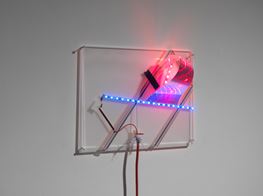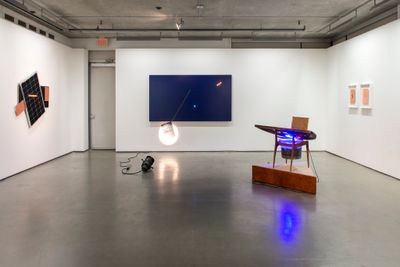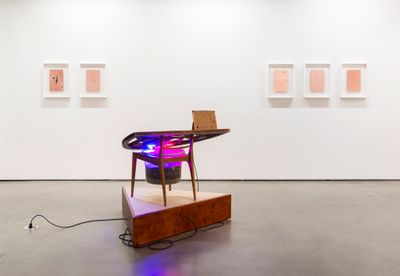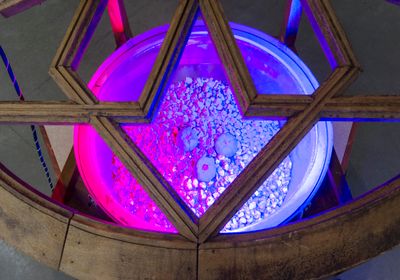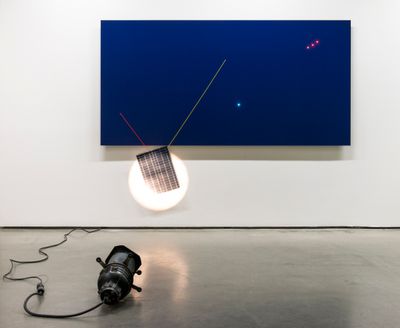Haroon Mirza
Haroon Mirza, 2011. Photo: Simon Pollock.
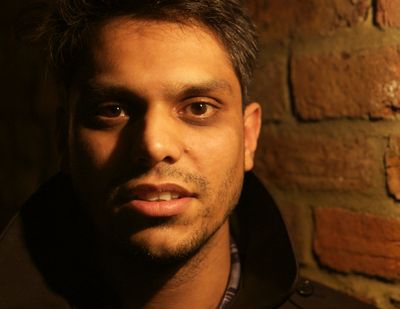
Haroon Mirza, 2011. Photo: Simon Pollock.
Haroon Mirza experiments with light, sound, electricity and other natural elements to create otherworldly compositions that manifest as kinetic sculptures encompassing installations, and mutable performances.
Though Mirza earned his BFA in painting and drawing at the School of the Art Institute of Chicago (exch and BA in fine art painting at the Winchester School of Art in 2002, an inclination for music and understanding the pragmatics of acoustic space led him to pursue a masters in design critical practice and theory at Goldsmiths College in London. He soon became fascinated with prototyping and self-governing systems, which in turn took him toward DIY engineering.
This journey was one of trial and error filled with electrical shocks and minor explosions, resulting in smooth integrations of LED lights with vintage speakers, wires and bare cords, exposing the intimate connections between seemingly discrete objects. Several works incorporate copper, the raw material of printed circuit boards. Five Liberty Caps (Solar Powered LED Circuit Composition 25) (2015) and Liberty Cap (Solar Powered LED Circuit Composition 27) (2015), for example, run solar energy through liberty cap mushrooms printed on circuit boards, creating reliefs. In recent years Mirza's work has garnered commendations, such as the Calder Prize in 2015, and the Nam June Paik Art Center Prize in 2014.
Most recently, Mirza has been working on a large-scale public sculpture for Ballroom Marfa, which will be unveiled in a group exhibition in March 2017. The semi-permanent commission, The Stone Circle, references man-made historical monuments and their connections with the earth. Through a combination of black marble, solar panels, and generated sound and light waves, the work encapsulates his interests in physical interference and cosmological consciousness.
The London-based artist has also been preparing for his first solo show in Canada at Vancouver's Contemporary Art Gallery, titled Entheogens (13 January–19 March 2017), which means: 'generating the divine from within'. The exhibition will present new commissions as well as ããã, an eight-channel installation produced at São Paulo's PIVÔ residency in 2016. The show also introduces psychotropic plants to Mirza's oeuvre, lending an air of intangible possibility to the materially grounded work.
Ocula talked with Mirza about his upcoming show, and the connections between his compositions and the cosmos.
My interests lie in consciousness, and how consciousness relates to scientific endeavours...
IMEntheogens features an array of psychotropics, like magic mushrooms, peyote, and the San Pedro cactus. What first drew you to these organic materials?
HMI've worked with organic materials before quite a lot, mainly water and ants. I've also worked with plants before, but not in any great detail. I've always been interested in organic matter, material, and organisms because of their chaotic, unpredictable and autonomous nature, and also as a metaphor for other things - water and the sound of water is quite interesting because it produces white noise.
Ants are chaotic systems, so you can create truly chaotic systems from using natural material. But then, on top of that, I've used a natural material constantly in my work over the last ten years: electricity. Electricity is also a natural phenomenon, which we kind of think we control but we don't really. Electricity is completely chaotic.
IMThere's an interesting tension between the chaotic and the controlled. Your work with ants seems to embody this, as they represent elements that are both uncontrollable and quite orderly.
HMThe most recent piece I developed with ants was called Pavilion for Optimisation (2013). To talk about the ants in the work, the term 'optimisation' is a mathematical reference to a kind of logic. So for instance, satellite navigation systems use optimisation algorithms, which they derive from ants. Ants find a food source and use pheromones to communicate where that source is in relation to their nest, and then find the shortest route from the nest to the food and communicate that.
That method of communication and of finding the shortest route is also how navigation systems work. And it's similar with water. If you think of a window when it's raining, you get the little droplets of water coming down a window. The water works as a whole to create the shortest routes, and then other particles of water can join and follow the same route. It's partly to do with gravity as well, but there is sort of this optimisation logic that takes place, which is chaotic but controlled. So there is that tension in nature.
Chaos theory itself is about those sorts of structures and logic in chaotic systems, like patterns, recognition, and microcosms. These are really exemplified by fractals, like in geometry. Fractals kind of work their way back round to psychedelics and entheogens, because they're a part of what's more commonly known as entoptic phenomenon, which is commonly what's seen when you ingest psychedelics or you have endogenous-altered states of consciousness. Whether it's induced by psychedelics or by other natural means - stress to the body, for instance - that's the first stage of psychedelic experience: images of geometric patterns and fractals.
IMWould you say that it was the idea of fractals that led you to psychedelics?
HMThe first thing that led me to psychedelics was just being a teenager and doing LSD. Taking acid as a kid, that was my first interaction with psychedelics. Then it kind of went away and I sort of made sure to not really take drugs and concentrate on other things. But I know full well those kinds of experiences have had a profound influence on my aesthetic and theoretical taste, specifically the aesthetics of audio or the timbre of sound that I adopt in my work. It predates going to Brazil, but that trip did lead me to ayahuasca.
My interests lie in consciousness, and how consciousness relates to scientific endeavours: what we know about the physical world and universe, and how that doesn't make sense in terms of metaphysics and consciousness, because we don't understand consciousness in scientific terms. But we claim to understand it through either religion or other forms of spiritual engagement, whether it's yoga, Vedic traditions or more westernised traditions of spiritual practice, or these mind-altering substances or practices that do the same thing.
It's the same effect. It's not a proven thing, but it could be argued that a high-level effect of yoga is DMT releasing in the mind, which is the same as meditating or other spiritual experiences. It's linking these metaphysical and physical things, which are what we know about the world and the universe. But what joins these two together is consciousness, and that's the crux of my interest.
IMThat takes me back to 'entheogen,' a word that means 'generating the divine from within'. This seems to frame an exploration of connections between the sacred and the spiritual, and there's certainly a long engagement in your work with religious traditions.
In particular, I'm reminded of your installation Adam, Eve, others and a UFO (2013), in which a selection of speakers are placed in the round to create a chamber of electric currents that are translated to sound.
HMThat's a funny one, because those words literally refer to objects that are in the piece. There's a speaker that's branded an 'Adam' speaker and there's another that's branded 'Eve'—they're kind of similar marketing schemes. Then there's a little LED device that is called a UFO.
So 'the others' are just the other speakers in the installation, but at the same time they set up this sort of narrative that has all these references. It's a two-fold thing. It's about the real, everyday reality of the physical, reductionist, materialist world that we live in, which we sort of have to accept somehow to come to consensus.
But then it also refers to this metaphysical, spiritual world that we don't really have any access to. We're not allowed legally to take a plant out of the ground and ingest it; we literally don't have access to this other world, or other level of consciousness.
IMCopper features as much as pyschotropics in the exhibition. Could you explain the production behind some of the copper works?
HMThere are various processes that are going on. The caps of the mushrooms are placed onto the copper and release spores to reproduce, so you get prints that are the fingerprint of the mushroom. Some are done like that, some are electro-etched. Through the mushroom you run a negative charge, and you complete the circuit with a positive charge on the copper so the moisture in the mushroom will actually oxidise on the copper itself.
That can be quite beautiful, and specifically beautiful with the peyote cactus and the San Pedro cacti. A lot of the titles refer to what they look like, so there's one that looks like a cosmological nebula, and one that looks like a comet. Sometimes the titles are just descriptive of what they are - some of the mushrooms refer to constellations.
IMAll very tied to cosmological terminology.
HMYes, there's a sort of cosmological narrative in there - this relationship with cosmology, ritual, and psychedelic experience that kind of collapses. That's identified mostly in Dec 21 [a work included in the Contemporary Art Gallery show], which is a representation of an astrotheological idea. Astrotheologists are a group of people who believe that many religions are tied to celestial events.
One of the most famous is the astronomical event happens every 21 December: Winter Solstice. If you look up at the sky on 21 December, you will see Orion. Orion's Belt has been known throughout history as the Three Kings, and also referred to as the Three Wise Men. Southwest of that is a very bright star called Sirius, which is in the Canis Major constellation.
If you make a line from the three stars of Orion's Belt to Sirius and continue that line to the horizon, on that point is where Virgo and the sun both rise. Astrotheologists believe it was the personification of this event that led to lots of religious ideas.
Nativity, for example, is apparently based on this: the Three Kings in the story follow the brightest star in the sky, and then the Virgin Mary gives birth to the Son. When you personify these celestial objects, the story and the myth grows.
IMI wanted to ask about your titles, as they often play with language and linguistic systems. I'm thinking of the 2014 exhibition at the Irish Museum of Modern Art, Are jee be? (8 March–8 June 2014), and /o/o/o/o/ at Lisson Gallery (17 May - 29 June 2013). Could you describe your constructions and, in particular, how you pronounce the title of the work ããã?
HMIt's pronounced 'ahh,' like you're thinking about something. It's a funny one, because it's playing with typography. This has more to do about typography and syntax, typography and its relation to sound and linguistics.
It comes from, in a convoluted way, McLuhan's idea of acoustics in visual space. He talks about how pre-linguistic man perceived visual space and acoustic space as one form of perception. It was only with language and the advent of syntax and spoken word that we started abstracting the thing itself. —[O]

